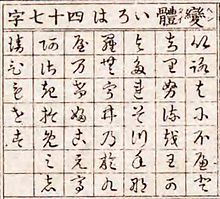Hentaigana
This article may be expanded with text translated from the corresponding article in Japanese. (August 2021) Click [show] for important translation instructions.
|
| Hentaigana | |
|---|---|
| Script type | |
Time period | c. 800 – 1900 CE; minor use at present |
| Languages | Japanese |
| Related scripts | |
Parent systems | Oracle Bone Script
|
Sister systems | Katakana, Hiragana |
| ISO 15924 | |
| ISO 15924 | Hira, , Hiragana |
| Unicode | |
Unicode alias | Hiragana |
Unicode range |
|
 |
| Japanese writing |
|---|
| Components |
| Uses |
| Romanization |
In the Japanese writing system, hentaigana (変体仮名, 変体がな, Japanese pronunciation: [hentaiɡana] or [hentaꜜiɡana], lit. "variant kana")[a] are variant forms of hiragana.[2]
History[]


Today, with few exceptions, there is only one hiragana for each of the fifty moras that are written without diacritics or digraphs. However, traditionally there were generally several more-or-less interchangeable hiragana for each. A 1900 script reform[b] ordained that only one selected character be used for each mora, with the rest deemed hentaigana. Today, although not normally used in publication, hentaigana are still used in shop signs and brand names to create a traditional or antiquated air.
Hiragana originate in man'yōgana, a system where kanji were used to write sounds without regard to their meaning. There was more than one kanji that could be used equivalently for each syllable (at the time, a syllable was a mora). Over time the man'yōgana was reduced to a cursive form, the hiragana. Many hentaigana derive from different kanji from the ones for the now-standard hiragana, but some are the result of different styles of cursive writing. As hentaigana have derived from man'yōgana, there are hundreds of different hentaigana used to represent only 90 moras of the Japanese language.
Katakana have variant forms, too. For example, ![]() (ネ) and
(ネ) and ![]() (ヰ).[4] However, katakana's variant forms are fewer than hiragana's ones. Katakana's choices of man'yōgana segments had stabilized early on and established – with few exceptions – an unambiguous phonemic orthography (one symbol per sound) long before the 1900 script regularization.[5]
(ヰ).[4] However, katakana's variant forms are fewer than hiragana's ones. Katakana's choices of man'yōgana segments had stabilized early on and established – with few exceptions – an unambiguous phonemic orthography (one symbol per sound) long before the 1900 script regularization.[5]
Standardized hentaigana[]
Prior to the proposal which led to the inclusion of hentaigana in Unicode 10.0, they were already Standardized into a list by Mojikiban, part of the Japanese Information-technology Promotion Agency (IPA).[6]
| a | i | u | e | o | |
|---|---|---|---|---|---|
| ∅ | あ(安) | い(以) | う(宇) | え(衣) | お(於) |